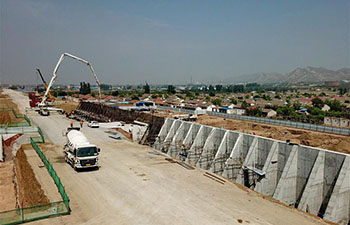WASHINGTON, June 14 (Xinhua) -- Astronomers have directly "seen" the formation and expansion of a fast-moving jet of material ejected when the powerful gravity of a supermassive black hole ripped apart a star that wandered too close to it.
They reported on Thursday in the journal Science the event in a pair of colliding galaxies called Arp 299, nearly 150 million light-years from Earth.
At the core of one of the galaxies, a black hole 20 million times more massive than the Sun shredded a star more than twice the Sun's mass, setting off a chain of events that revealed important details of the violent encounter, according to the study.
Theorists suggested that material pulled from the doomed star forms a rotating disk around the black hole, emitting intense X-rays and visible light, and also launches jets of material outward from the poles of the disk at nearly the speed of light.
"Never before have we been able to directly observe the formation and evolution of a jet from one of these events," said Miguel Perez-Torres with the Astrophysical Institute of Andalusia in Granada, Spain.
The first indication came on Jan. 30, 2005, when astronomers using the William Herschel Telescope in the Canary Islands discovered a bright burst of infrared emission coming from the nucleus of one of the colliding galaxies in Arp 299.
On July 17, 2005, the Very Long Baseline Array (VLBA) in the United States revealed a new, distinct source of radio emission from the same location.
"As time passed, the new object stayed bright at infrared and radio wavelengths, but not in visible light and X-rays," said Seppo Mattila with the University of Turku in Finland.
"The most likely explanation is that thick interstellar gas and dust near the galaxy's center absorbed the X-rays and visible light, then re-radiated it as infrared," said Mattila.
Also, continued observations with the VLBA, the European VLBI Network (EVN), and other radio telescopes, carried out over nearly a decade, showed the source of radio emission expanding in one direction, just as expected for a jet.
The measured expansion indicated that the material in the jet moved at an average of one-fourth the speed of light. The radio waves are not absorbed in the core of the galaxy, but find their way through it to reach the Earth.
The discovery, the scientists said, came as a surprise. The initial infrared burst was discovered as part of a project that sought to detect supernova explosions in such colliding pairs of galaxies. Arp 299 has seen numerous stellar explosions, and has been dubbed a "supernova factory."
This new object originally was considered to be a supernova explosion. Only in 2011, six years after discovery, the radio-emitting portion began to show an elongation.
Subsequent monitoring showed the expansion growing, confirming that what the scientists are seeing is a jet, not a supernova.

















